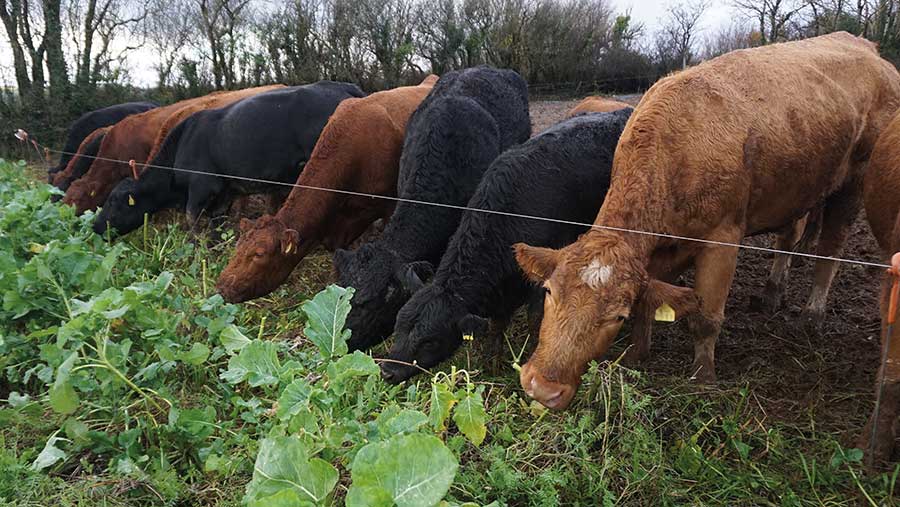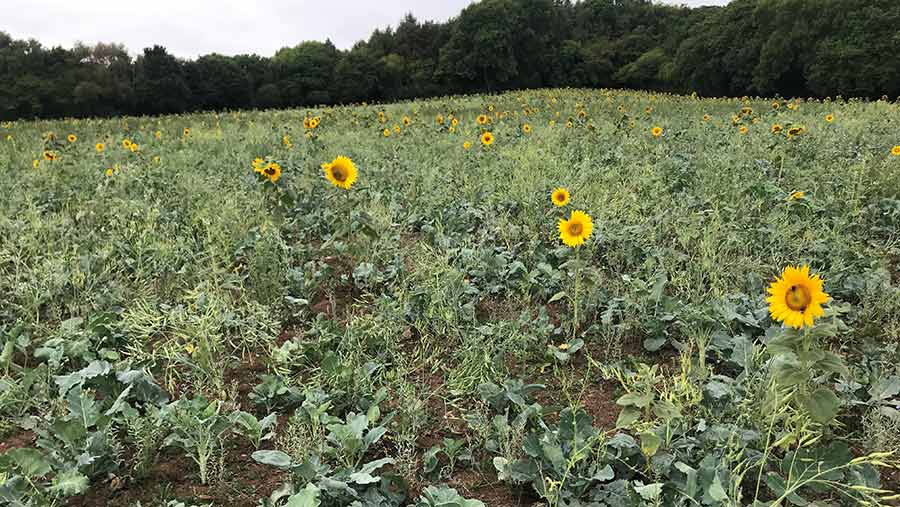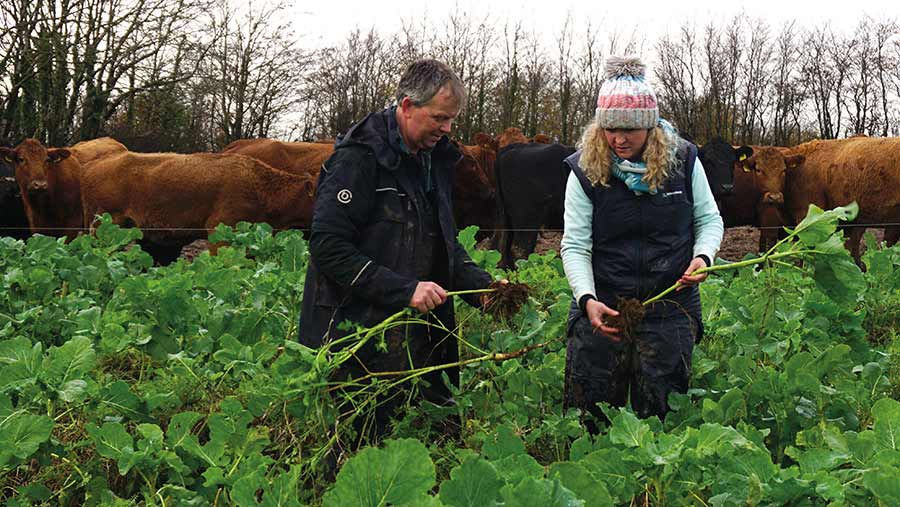Why diverse forage mixtures could improve outwintering
 © Innovative Farmers
© Innovative Farmers Findings from a recent trial in Devon have concluded that outwintering cattle on a diverse mix of forages can help improve both animal and soil health, while also benefiting the wider environment.
The study, facilitated by Innovative Farmers and supported by the Farming and Wildlife Advisory Group (FWAG), came about as the result of a “field lab”.
See also: How multispecies swards can improve production efficiency
This sought to explore the relatively untapped area of using diverse forage mixtures for outwintering livestock, rather than monoculture brassicas, explains FWAG’s Sarah Whaley, who led the research.
“In a standard monocropping brassica system, we’re hammering our soils really hard,” says Ms Whaley.
“We’re trying to move away from this poached, muddy mess that sits there bare and is exposed to wind, rain and sediment loss. That sediment is your most valuable asset on farm because that’s your topsoil.
“Topsoil is something that you can’t just buy in in a bag – it’s really valuable and we need to protect it.”
Monocultures also offer relatively little in the way of environmental benefits, she adds.
The objectives of the study were multifaceted and included determining suitable plant species and varieties for winter grazing.
These would need to maintain green leaf area and ground cover year-round, as well as providing suitable nutrition to animals for rumination. They would also need to maintain, or increase, daily liveweight gain.
In addition, the trial looked at whether these crops could help extend winter grazing and produce a “second bite” for cattle – something that monocrops such as kale do not allow.
Researchers were also keen to explore the benefits of diverse mixtures to the soil and wider environment, as well as how they stack up financially when compared with current outwintering systems.
Trial design

© Innovative Farmers
The trial compared the performance of monoculture kale with a diverse forage mix at four beef farms across Devon and Somerset (see “Diverse forage trialist farms”) – two organic and two conventional – with every farm establishing 4ha (10 acres) of each crop.
The 16 species in the diverse mix were selected by the farmers for their soil health and ecological benefits, winter hardiness and fodder potential.
They comprised legumes, forbs (herbaceous flowering plants other than grasses), herbs, grasses and brassicas:
- White clover (2.9%)
- Berseem clover (1.1%)
- Crimson clover (1%)
- Alsike clover (1%)
- Hairy vetch (16%)
- Linseed (5.31%)
- Forage rape (2.1%)
- Kale (1.9%)
- Kale x rape hybrid (0.45%)
- Italian ryegrass (25.7%)
- Chicory (0.4%)
- Ribwort plantain (0.8%)
- Spring oats (28.6%)
- Tillage radish (5.7%)
- Sunflowers (6.2%)
- White millet (0.84%).
Cattle strip- or cell-grazed both plots, according to each farm’s grazing system, moving once or twice a day, depending on performance.
Grazing period ranged from November to January. Cattle were weighed and body condition scored at the beginning and end of the grazing, and crop quality, yield and utilisation were calculated.
Researchers also carried out soil analysis and earthworm counts, and adviser Mike Ingram from FWAG SW’s ecology team was brought in to carry out a bird survey to better understand if there was any impact on biodiversity.
Trial findings
Results varied from farm to farm, with all four trial sites observing significant differences in establishment and yields, as well as the timing and availability of the feed.
Cattle moved through the diverse forage mix more quickly. “This requires greater land area, but potentially less supplementary feed. This could be improved with more winter-hardy species within the mix,” suggests Ms Whaley.
Cattle grazing the diverse forage mix had consistently better dung scores.
There were also soil and environment benefits:
- Improvements to soil health, structure and aggregation
- Reduction in poaching and run-off and better water infiltration
- Increases in soil organisms and improvement in soil cycling of organic matter
- Increases in biodiversity, including pollinators, insects and birds. Seed-eating birds including linnets, chaffinches, goldfinches and greenfinches were all present in large flocks
- Better sward recovery, with minimal bare ground left exposed over winter.
Next steps
The findings are drawn from one year’s data, so further research is needed to perfect the mix and better understand how diverse species could offer advantages over traditional monocropping, explains Ms Whaley.
More work is expected to take place over the coming months and will focus on five key areas:
- Increasing the quantity of winter-hardy species
- Management of grazing and stocking density to encourage better recovery and regrowth
- Timing of grazing to maximise forage value
- Which stock class is best suited to outwintering and the diverse forage mix
- Compensatory growth when stock are moved off kale and the diverse forage mix on to spring pastures.
View from the field – Tom Armitage, Lower Brown Farm

Tom Armitage and Sarah Whaley © Innovative Farmers
Tom Armitage has seen positive results during the first year of trials at his 567ha (1,400-acre) organic upland farm near Huish Champflower, Somerset.
The farm is home to more than 900-head of cattle, including a 200-head suckler herd of Stabilisers. Outwintering is a long-standing part of the system and everything on farm is finished off forage.
Mr Armitage’s outwintering system is based on a combination of diverse winter mixtures, kale and bale grazing. He got involved in the trial to further explore the potential of the diverse mixes.
The kale plot was drilled on 7 May 2022, following a three-year clover ley, at a seed rate of 5kg/ha and a cost of £62.50/ha. The diverse mix was sown on 10 May, following fodder beet, at a seed rate of 33kg/ha, and cost £88.50/ha.
Both plots were ploughed, rolled, power-harrowed, drilled, then rolled again. Neither received any inputs.
A cow group and a calf group strip-grazed the diverse forage plot from mid-November, moving twice daily, with the crop providing 48 head of cattle with 48 days of grazing.
Yields and costs
At the time of grazing, yield analysis was calculated at 6.17t dry matter (DM)/ha in the kale plot and 6.04t DM/ha in the trial plot.
These yields were calculated by consultants at Precision Grazing, using animal energy requirements for the grazing period.
Based on grazing 48 animals for 48 days, the total cost a head a day was 76p for the kale and 70p for the diverse forage mix.
Average daily liveweight gain for the calf group was higher on kale, at 900g, compared with 530g on the diverse forage mix.
Supplementary feed was needed with both crops, but more had to be fed with the kale, resulting in a higher cost overall.
Mr Armitage says he would reconsider including tillage radish as it came through early and dominated the diverse forage mix, before dying off. This impacted feed availability and subsequent animal performance.
He plans to add oats, peas, beans and barley into the mix for next year and is aiming to direct drill it in July.
Diverse forage trial farms
- Chris Berry – Higher Thornton Farm, Kenn, Devon; April-June-born Angus calves
- Richard Stanbury – Weston Farm, Knowstone, Devon; 21-22-month-old Devon Reds
- George Greed – Fortescue Farm, Thorverton, Devon; in-calf Aberdeen Angus and Red Polls
- Tom Armitage – Lower Brown Farm, Huish Champflower, Somerset; Stabiliser cows and April-born calves
